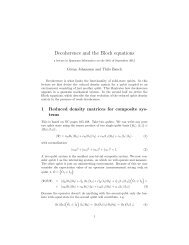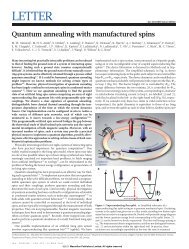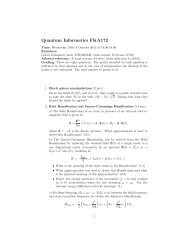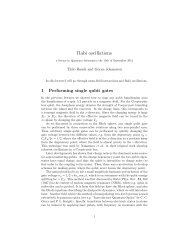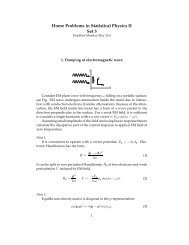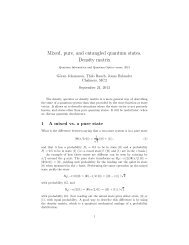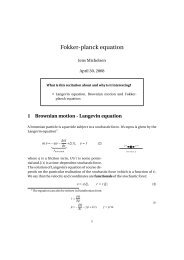Density Matrix for Harmonic Oscillator
Density Matrix for Harmonic Oscillator
Density Matrix for Harmonic Oscillator
You also want an ePaper? Increase the reach of your titles
YUMPU automatically turns print PDFs into web optimized ePapers that Google loves.
and it follows that〈a † 〉 = 1 Z Tr[a† ρ] = 0〈a〉 = 1 Z Tr[aρ] = 0 (50)Due to this we have a quite simple expression <strong>for</strong> the average position〈X 〉 = 1 )(〈a † 〉 + 〈a〉 = 02〈K 〉 = i)(〈a † 〉 − 〈a〉 = 02(51)and similarly <strong>for</strong> the mean square deviations〈X 2 〉 = 1 2 〈(a† + a) 2 〉 = 1 ()〈a † a † 〉 + 〈a † a〉 + 〈aa † 〉 + 〈aa〉2〈K 2 〉 = − 1 2 〈(a† − a) 2 〉 = 1 () (52)−〈a † a † 〉 + 〈a † a〉 + 〈aa † 〉 − 〈aa〉2because of 〈n|a † a † n〉 = 0 and 〈n|aan〉 = 0 we have only〈X 2 〉 = 〈K 2 〉 = 〈a † a〉 + 〈aa † 〉 (53)and it remains to evaluate 〈a † a〉 and 〈aa † 〉. To do this I shall use two things.1. Baker-Campbell-Haussdorf theorem e βH ae −βH = ae −βħω2. Cyclic property of the trace Tr[ABC ] = Tr[BC A] = Tr[C AB]Using these we can find the following relationship:〈a † a〉 = Z −1 Tr[a † aρ] = Z −1 Tr[a † ae −βH ] = Z −1 Tr[a † e} −βH {{e βH}ae −βH ]=I= Z −1 Tr[a † e −βH e} βH ae{{ −βH}] = Z −1 Tr[a † e −βH a]e −βħω = Z −1 Tr[aa † e −βH ]e −βħωae −βħω= 〈aa † 〉e −βħω (54)Now using the commutation relation [a, a † ] = 1:1 = 〈[a, a † ]〉 = 〈aa † 〉 − 〈a † a〉 = 〈a † a〉(e βħω − 1) (55)or〈a † a〉 = 1/(e βħω − 1) and 〈aa † 〉 = −1/(e −βħω − 1) (56)8



